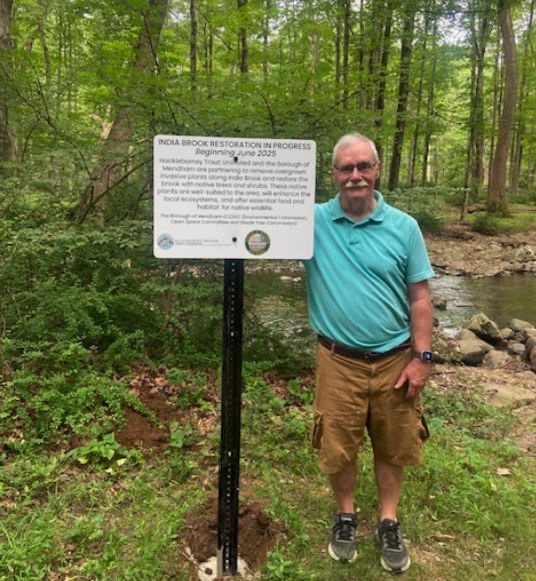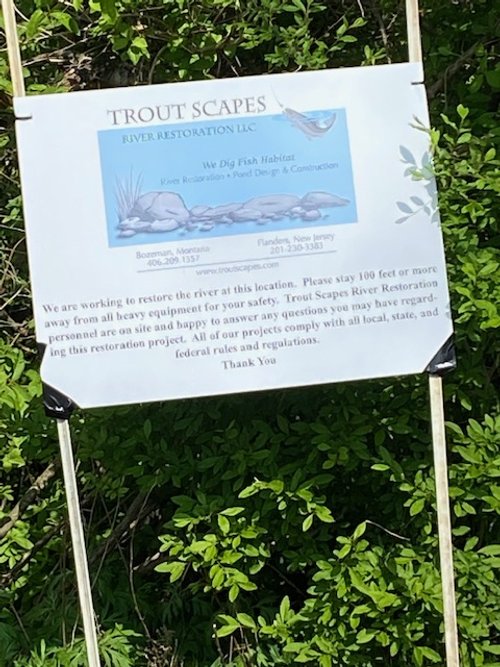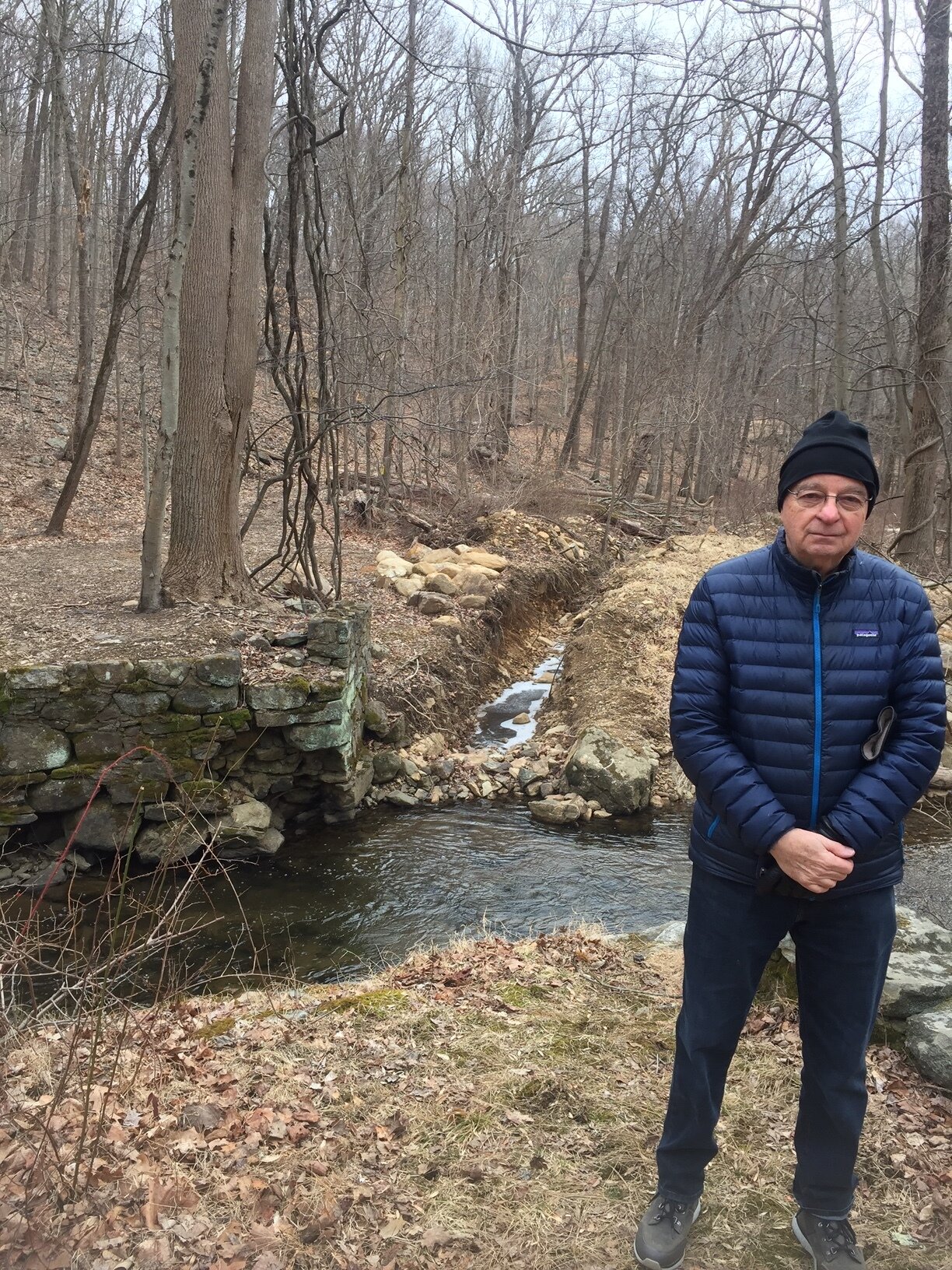India Brook Restoration Project
India Brook runs through India Brook Park in bucolic Mendham Borough. People come from all over to enjoy India Brook Park. India Brook is a Category One stream and hosts both wild and stocked trout. Category One waters are high quality waters designated for protection from measurable changes in water quality because of their exceptional ecological significance, exceptional water supply significance, exceptional recreational significance, and exceptional fisheries significance to protect and maintain their water quality, aesthetic value, and ecological integrity. India Brook and India Brook Park have recently experienced flooding, drought, tree diseases, human impingement, and deer over-browsing.
With these challenges Hacklebarney Trout Unlimited and the Borough of Mendham, environmental and park and recreation committees have joined together to protect the stream from the possible destruction of the environment. The India Book Restoration Project (IBRP) has been formed to address these issues.
Our Goal:
Create a sustainable habitat for trout in India Brook that supports biodiversity while enhancing opportunities for recreational fishing.
Restoration Plan Objectives:
Improve Water Quality and Temperature Regulation
•Riparian Buffers: Establish or expand native vegetative buffers using deep-rooted trees and shrubs. Thes buffers provide essential shade to maintain cooler water temperatures and act as natural filters, reducing pollutants and excess nutrients from surface runoff.
•Erosion and Sediment Control: Stabilize eroding streambanks with a combination of native vegetation, coir logs, live stakes, and root wads. These natural reinforcements will help sedimentation and maintain stream clarity.
2. Enhance In-stream Habitat for Trout
•Habitat Structures: Install large woody debris, root wads, , and strategically placed rocks to create a diverse stream structure with riffles, pools, and runs. These features offer trout critical shelter, feeding areas, and spawning habitat, while riffles help oxygenate the water.
•Boulder Clusters and Log Vanes: Use boulder clusters and log vanes to direct stream flow, forming a mix of slower pools for resting and feeding and faster runs that provide oxygen-rich habitat.
3. Monitor Stream Health and Resilience
•Temperature and Flow Monitoring: Regularly monitor water temperature and flow, particularly during the summer months. The data will guide adaptive management strategies and help assess the effectiveness of restoration efforts.
Community Engagement and Stewardship
•Education and Outreach: Educate residents, schools, and civic groups about trout habitat needs and how restoration enhances wild and native trout populations.
•Volunteer Involvement: Involve community members in stream monitoring and ongoing maintenance efforts. Activities may include removing invasive plants, annual streamed cleanups, trash removal, and assisting with post-restoration monitoring of fish populations and stream health.
4. Long-term monitoring
•Routine Assessments: Conduct regular fish population surveys, water quality testing, and visual stream inspections to monitor the brooks response to restoration. These data support adaptive management to refine efforts and ensure optimal habitat conditions.
•Partner Monitoring Efforts: These efforts will improve overall stream health, benefit trout and other aquatic species while supporting a sustainable , self-regulating ecosystem.
For more information or to volunteer contact Hacklebarney Trout Unlimited at htuprez@gmail.com
India Brook Restoration Project Sponsors
The India Brook Restoration Project would not be possible without the generous support and leadership of the following conservation-minded organizations. Their commitment to protecting coldwater fisheries and restoring New Jersey’s natural habitats is making a lasting impact in Mendham and beyond.
Hacklebarney Trout Unlimited Chapter
Local leadership and boots-on-the-ground stewardship driving this community-based restoration effort.
•Borough of Mendham
•Municipal partner providing vital support, coordination, and long-term commitment to protecting open space and environmental health.
•New Jersey Council Trout Unlimited -Statewide Trout Unlimited network championing cold water conservation efforts and supporting local chapters like Hacklebarney TU.
•Theodore Gordon Flyfishers, Inc. -A nonprofit fly fishing and conservation organization funding stream restoration and trout habitat protection throughout the Northeast.
•New Jersey Corporate Wetlands Restoration Partnership -A public-private partnership investing in habitat restoration, wetland enhancement, and resilient ecosystems across New Jersey.
Andrew Keating, Henry Bayard, Steve Widuta, Brian Cowden, and Marc Weiner inspecting the North Branch in Mendham Township
Ralston Stream Restoration First Year Report
October 2022 Brian Cowden of Trout Scapes River Restoration LLC (TRSS) and Michael Peters, president of the Hacklebarney Trout Chapter of Unlimited assessed the condition of the North Branch of the Raritan River (NBR) between the Ironia Road bridge and the Route 24 bridge in Mendham Township. They found that the NBR in Ralston has dramatically degraded in recent years, mostly due to flooding from increasing flood events. Pools have filled with sediment, the channel is shifting in places because of the added cobbles moving in from upstream, and the banks are showing increased signs of erosion.
November 2022 A conceptual design was created by TRSS to show how the river could be restored providing shelter for the fish and be better able to handle high flow events. The seven landowners were contacted and each given a copy of the design.
February 2023 A meeting of the landowners was held on Sunday, February 4th where Brian explained the plan and answered questions from the landowners. The consensus was to move forward with the overall plan and that a non-profit organization should be created to apply for a grant from the Natural Resources Conservation Service (NRCS) to pay for the restoration.
August 2023 A 501(c)(3) organization was created for the sole purpose of restoring the stream.
October 2023 A preliminary application for the restoration was sent to the Natural Resources Conservation Service.
Anticipated Work To Be Done
December 2023 Site visit with NRCS staff and TSRR who is a Technical Service Provider (TSP) to qualify the site
2024
-Pre-restoration monitoring by Hacklebarney TU members and Raritan Headwaters Association..
-Approvals and permits.
Fall 2024
-TSRR to survey, using licensed NJ surveyor, the approximately 3,000’ of the river
Winter 2024/2025
-TRSS to complete a permit-ready design and work with NRCS staff on permitting
Summer 2025
-Stream restoration by Trout Scapes River Restoration, LLC
Fall 2025
-Tree planting by Hacklebarney TU members.
2026 and beyond
-Stream monitoring to determine the success of the restoration.
North Branch restoration below the Route 24 bridge in Mendham Township, May 11, 2023
Ralston Stream Restoration, March 1, 2023
In September of 2022 Hacklebarney TU Chapter president, Michael Peters, contacted Brian Cowden of Trout Scapes River Restoration, LLC to look at a potential project in Mendham Township, New Jersey. They looked at the condition of the North Branch of the Raritan River on the north side of the Route 24 bridge going to the Ironia Road bridge. This area is know as the Ralston Historic District and is listed in the National Register of Historic Places. The stream that runs through Ralston is also the home to wild brown trout, and its tributaries have native brook trout as well. Michael is a lifelong Mendham resident and knows the stream very well. He and Brian found that the NBR in Ralston has dramatically degraded in recent years, mostly due to flooding from increasing flood events. Pools have filled with sediment, the channel is shifting in places because of the added cobbles moving in from upstream, and the banks are showing increased signs of erosion.
The North Branch is the headwaters of one of the most important rivers in New Jersey, a river that supplies drinking water for three to five million New Jersey residents daily. Michael contacted the eight landowners and discussed the restoration of approximately 3,000’ of river that runs through their properties. Trout Scapes presented to them a conceptual design for the restoration work that they recommend. The design includes more than twenty pools capable of holding fish during low water periods and gravel runs suitable for redds as well as bank restoration and protection as needed. Any historic diversions could be maintained as a part of the project and the river will be better able to handle high flow events once restored. As you know, Trout Unlimited is a non-profit organization that brings together diverse interests to care for and recover rivers and streams, so that our children can experience the joy of wild and native trout and salmon.
The seven landowners have approved of the concept and are forming a non-profit organization to request grant money to help fund this project. The Hacklebarney TU Chapter wants to support the Ralston Stream Restoration in any way it can.
India Brook Blockage in Mendham Township
Stream is almost completely blocked October 1, 2019 near old historic district bridge.
India Brook near old historic bridge is blocked on October 1, 2019
Rich Cotter reviews the site on February 16, 2020
“Save the Date: Saturday, April 13, 2019 -Cleanup The South Branch of the Raritan River in Long Valley. See details on CALENDAR.”
Jon Eng planting trees at the Paulinskill River
The Musky clean-up on 4/11/15, featuring the Russo clan!
Don, Jeff and Cliff hard at work sampling Kurtnebachs brook for life as part of the study to determine whether the brook is suitable for brook trout reproduction.
The Restoration of Eastern Heritage Brook Trout in Kurtenbach’s Brook is a Trout Unlimited (TU) Embrace-A-Stream Project.
Kurtenbach’s Brook is a known Heritage Brook Trout tributary of the Musconetcong River lying entirely within Stephens State Park in Mount Olive Township, New Jersey. The TUNJ State Council is working closely with TU’s Musconetcong Home Rivers Initiative (MHRI) on this project.
Kurtenbach’s Brook was redirected and forced into a man made channel in the 1960s to facilitate the construction of Interstate 80. As a result, the Brook Trout habitat was greatly impaired by channelization of the stream, hard armoring of the streambed, the addition of a now obsolete metal culvert, and the elimination of connectivity to the stream’s floodplain. Through electro fish sampling of this entire stream with NJ Fish &
Wildlife (NJ F&W) fisheries biologists, native brook trout populations in the affected lower reaches of this stream have been determined to be approximately 10% – 20% of those in the un-impacted upper stream, which remains intact and fully protected.
The purpose of this project is to restore the in stream habitat, reconnect the population of brook trout in the lower stretch to those in the upper stretch via culvert removal, and reconnect this important spawning tributary to its floodplain and the main Musconetcong River where accumulated sediment has caused low flow impasse to fish migration into and out of this tributary. The methods to be used to perform this work include culvert removal, bed load manipulation, and the construction of plunge pools on two sections of the stream where stone slides were built to accommodate significant elevation drops using Urbani Fisheries of Bozeman, Montana. The primary goal of the project is to increase the populations of brook trout to within 75% of the upstream population which will be determined over time through electro fishing with NJ F&W biologists. A secondary goal is to reconnect the mouth of this spawning tributary to the main river toconnect this fragmented population of brook trout with populations in other tributaries, strengthening their overall genetics in an Eastern Brook Trout Joint Venture (EBTJV) state that has seen wide spread extirpation of brook trout habitat.
The Hacklebarney TU chapter has seen multiple volunteers step forward to complete a series of seasonal pre construction macro invertebrate analysis to set a baseline for future studies.
Hacklebarney TU chapter conducted a comprehensive clean up effort of the brook with aid in the form of free dumpsters and hauling by State Parks in Spring 2011. Prior to the in stream construction, which is tentatively, scheduled (funding dependent) for summer 2014, TU volunteers will be used to remove non native, invasive trees and shrubs from the site and to create wide enough openings to accommodate the heavy equipment (small track hoe) to access the stream. These same volunteers will move small boulders from old stone walls located in close proximity to the stream into numerous marked piles to be used by the heavy equipment to stabilize the stream channel, build engineered riffle structures and plunge pools, and to provide in stream fish habitat. Once the construction phase of the project is completed,
Following restoration, the same members from Hacklebarney chapter that performed pre- restoration baseline studies of the macro invertebrates will monitor on a quarterly basis these aquatic insect populations for a time of three years. Additionally, TU volunteers, working with NJ F&W principal fisheries biologist, Pat Hamilton, will perform electro-fish sampling to determine post restoration fish populations also over a three-year period. Baseline population studies for both impacted and un-impacted sections of Kurtenbach’s are completed as noted earlier. Success will be considered by an increase of brook trout that matches as high as 75% or more of the upstream, un-impacted populations as determined by electro shock fishing. Macro invertebrate studies will further confirm the effectiveness of this project by proving that aquatic habitat has been restored with a corresponding increase in the food chain that trout rely on for survival. .
Having a Heritage brook trout stream located so closely to a major interstate highway, yet fully protected from development in the nation’s most densely populated state makes this project important in so many ways. If native brook trout populations can rebound in New Jersey, then they can rebound in far less populated states throughout their range using similar restoration techniques.
Some of the macroinvertabrate life from Kurtenbachs. Some baby crawfish, caddis, midge and mayfly larva.
Members seining the Whippany River during an invertebrate count
One of our members at the Whippany River clean up, doing good.
Some other volunteers at the Whippany River clean up. Thats a lot of garbage!

















